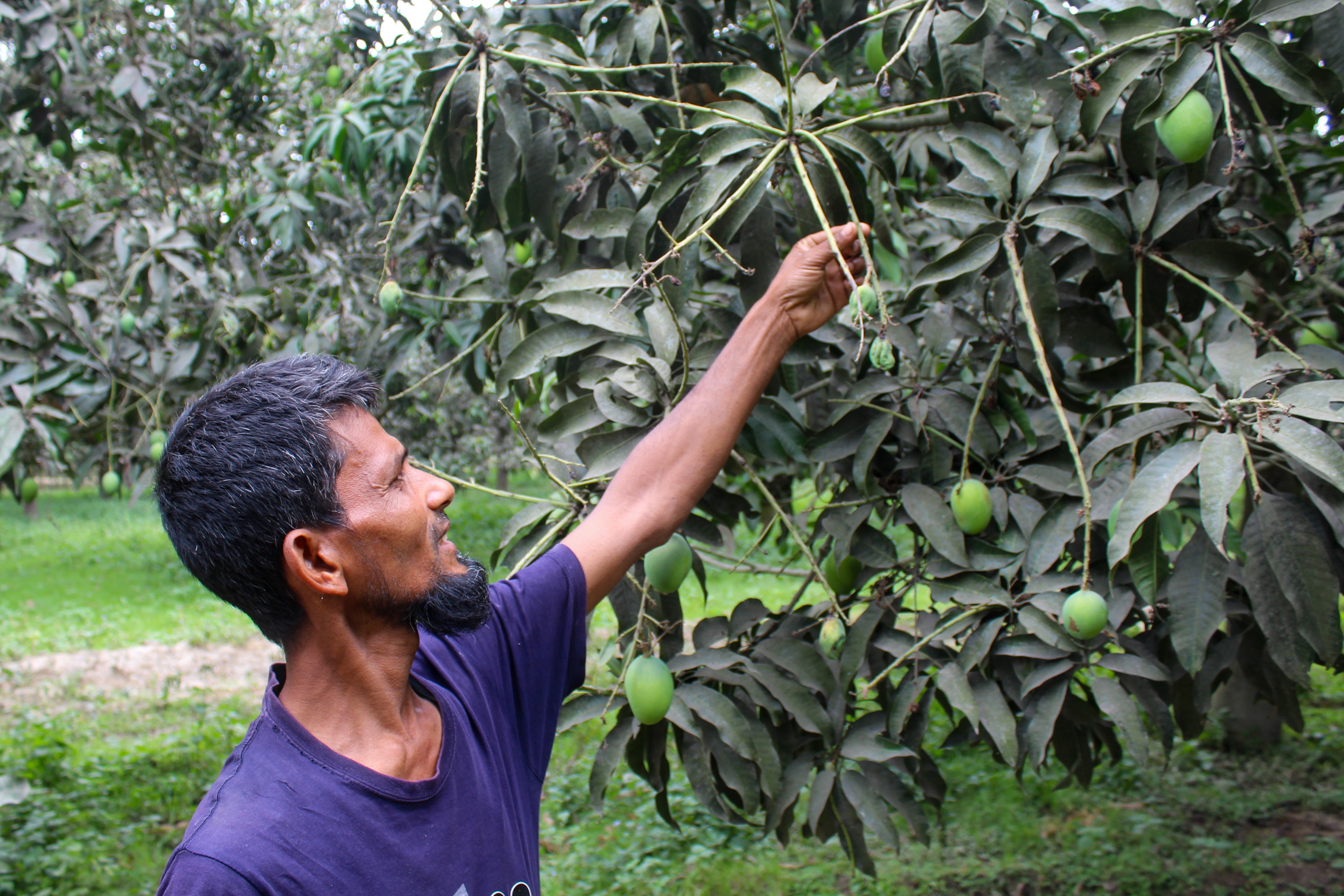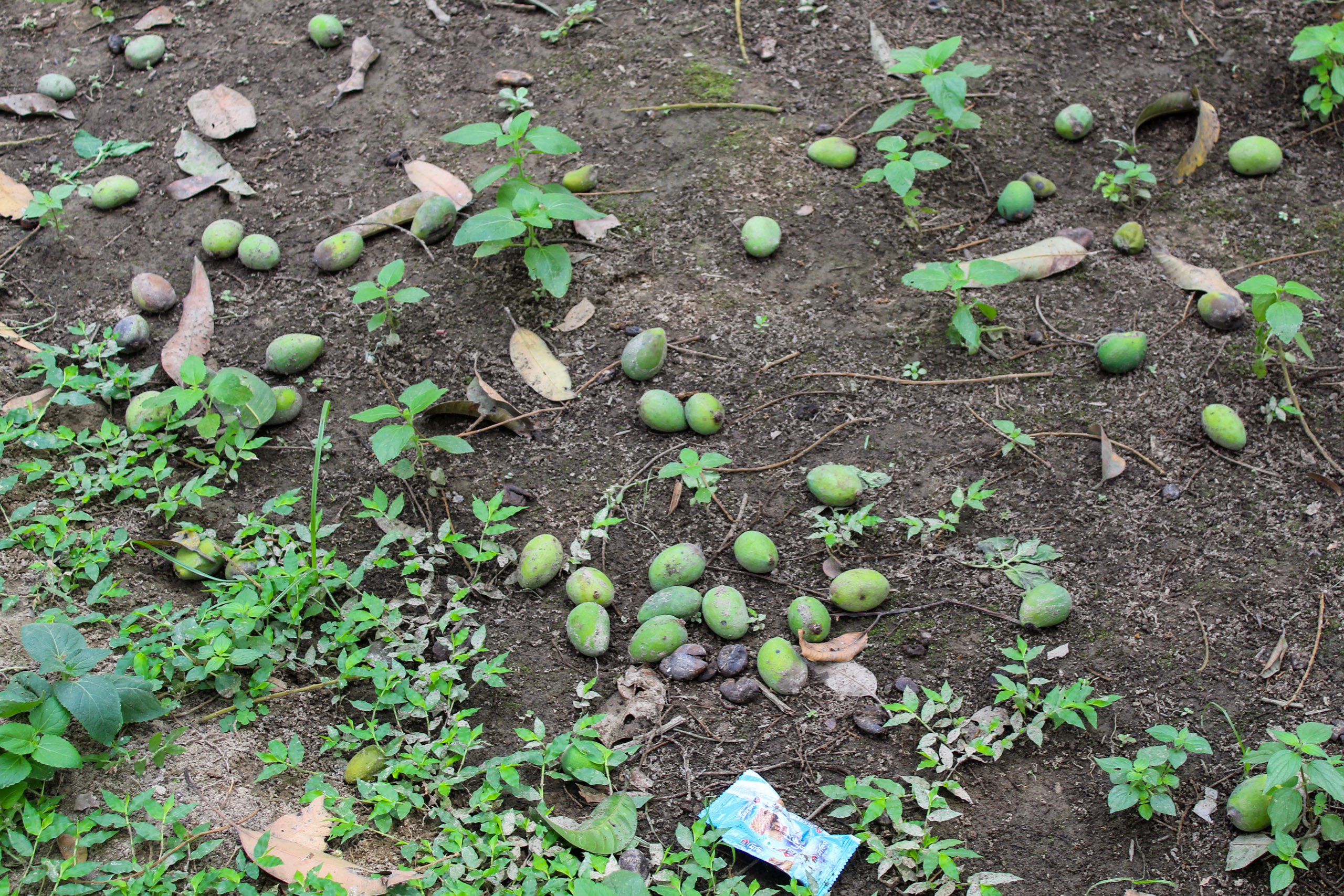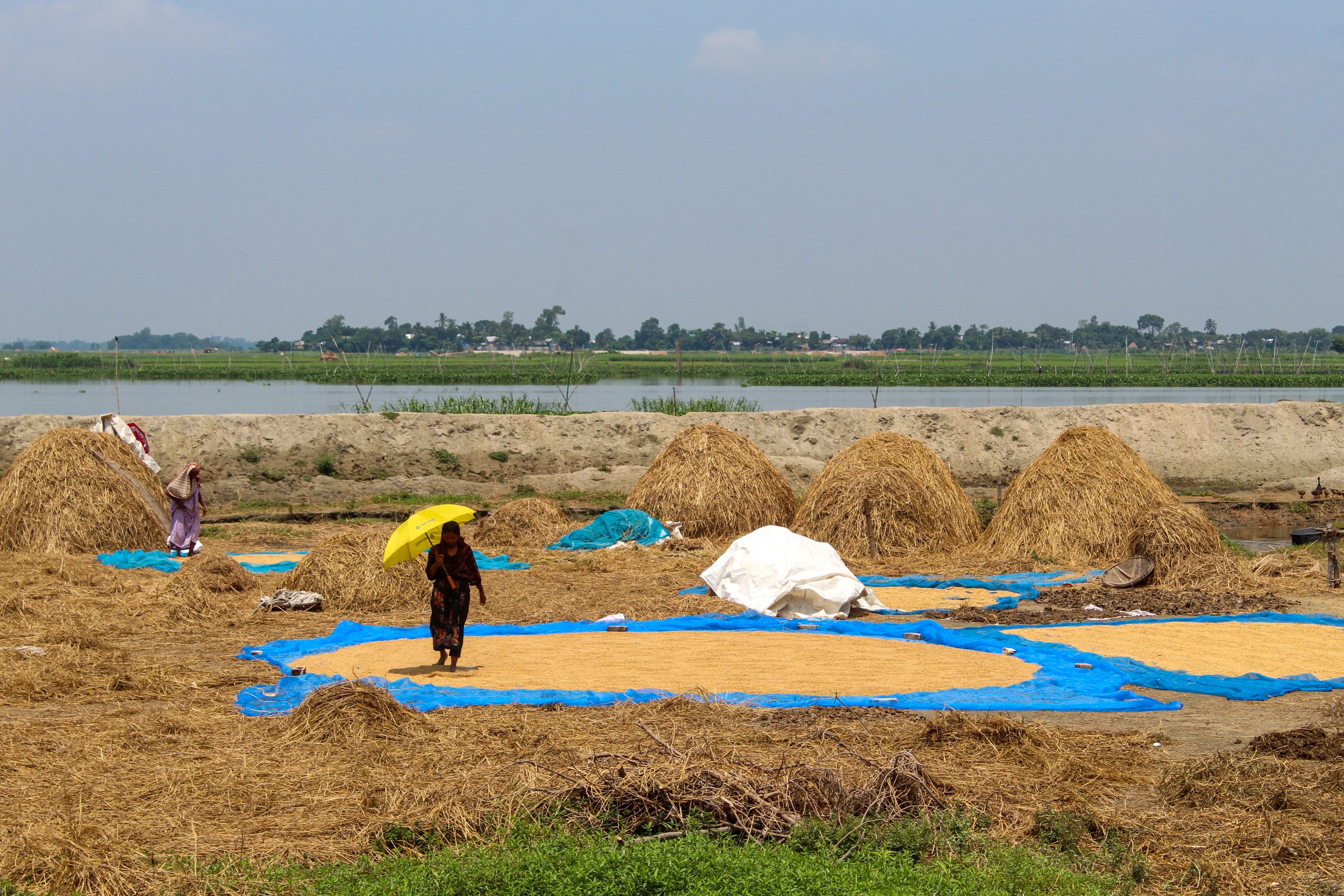
Extreme heat in Bangladesh on the back of frequent cyclones, droughts and floods is pushing the country further into a food security crisis. The intense heat, which peaked at a record 43.8°C in Jashore on April 30, caused widespread damage to agricultural sectors. A January 2024 report by the Grantham Research Institute of the London School of Economics (LSE) said that even if temperature rise is limited to below 2°C, the proportion of people affected by food insecurity in the country would increase by 4.4% between 2021- 2040.
Fruit production hit by heat
In mid-May, the scorching heatwave devastated mango orchards across Bangladesh. Ekelakh Hossain, a mango farmer in Biral Upazila, Dinajpur, witnessed the impact firsthand as young mangoes dried up and fell from the trees due to the intense heat.
“The soil in the orchards heated up so much that baby mangoes started drying and dropping from the trees,” Hossain told Dialogue Earth. “This year, mango production will be about 20 to 30% less than the previous year due to the severe heatwave.”
To protect his orchard, Hossain resorted to daily irrigation, costing him Bangladeshi Taka 1,000 (USD 8.54) per day in fuel. Last year, he spent a total of Taka 150,000 (USD 1,281) on mango production across his six-acre orchard. This year, he feared costs would double due to increased irrigation.
“The increased cost of production and reduced yield mean we won’t be able to make a profit this year,” Hossain lamented.
According to the Department of Agriculture Extension (DAE), Bangladesh produced approximately 2.3 million metric tonnes of mango in 2020-21, 2.5 million tonnes in 2021-22, and 2.35 million tonnes in 2022-23. Reports indicate that this year’s heatwave reduced mango output by 40%, causing prices to soar and straining the market.
It is not just mangoes that have suffered. Ashraful Islam, another farmer in Biral Upazila, faced similar challenges with his 45-acre lychee orchard. The intense heat caused lychee flowers to burn and immature fruits to fall prematurely.
“I cannot afford to stop [pumping water from] my deep tubewell even for a minute,” Islam said. “I have been irrigating my lychee orchard for seven consecutive days to protect the fruits from the heatwave.”
Islam estimates that the cost of lychee production would rise to around Taka 2.5 million this year [USD 21,280], compared to Taka 1 million [USD 8,512] last year.
The Bangladesh Bureau of Statistics (BBS) reported that 92,958 metric tonnes of lychee were produced in 2021-22 and 104,708 metric tonnes in 2022-23. However, KJM Abdul Awal, director of the horticulture wing at DAE, estimates that this year’s production for both lychee and mango will be reduced by 30% because of the heatwave.
Awal also highlighted the broader agricultural impact of intense heat, noting that household orchards of various fruits, including jackfruit, blackberry, coconut, papaya and custard apple, were also severely affected by the nationwide heatwave.
Abul Kalam Mallick, a meteorologist at the Bangladesh Meteorological Department told Dialogue Earth that the country experienced a total of 73 days of heatwaves in various spells this year, including a severe heatwave lasting 52 days in April and May. “The pattern and characteristics of heatwaves in Bangladesh have changed due to global climate change,” Mallick observed. “Heatwaves are now occurring even during the monsoon season.”
Rice at risk
Rice, the staple food for over 160 million people in Bangladesh, is crucial for the country’s food security. However, experts warn that the persistent high temperatures could negatively impact paddy production. Despite an increase in production last year, with 39.09 million tonnes of rice produced in 2022-23, compared to 38.14 million tonnes in 2021-22, the future looks uncertain.
Nur Ahmed Khondaker, assistant representative of the Food and Agriculture Organization of the United Nations to Bangladesh, explained that heatwaves severely affect paddy pollination and grain formation. “Water demand for rice production will increase in the future due to heatwaves. If paddy fields cannot be properly irrigated, production will fall,” he said.
Mohammad Khalequzzaman, director of research at the Bangladesh Rice Research Institute (BRRI), noted that both day and night temperatures have risen, disrupting the physiological processes of paddy plants.
“If we do not take enough preparation in the crop sector to deal with heatwaves, food production will decline,” Khalequzzaman warned. However, he mentioned that BRRI has developed a heat-tolerant paddy variety, which is currently under trial and is expected to be available to farmers next year.
Livestock and poultry also suffer
The heatwaves have also severely impacted Bangladesh’s livestock sector, particularly poultry. High temperatures have resulted in significant chicken mortality and reduced egg production.
Badrul Alam Noman, a poultry farmer in Kishoreganj, reported that chickens ate less feed during the latest heatwave, leading to slower growth and lower egg production. “Egg production decreased by 20 to 30% and broiler chickens weighed 300-400 grams less on average,” he said.
Rising costs and labour challenges
The heatwave has also increased labour costs across the agriculture sector, as many workers either avoid working in extreme heat or demand higher wages for doing so.
Masum Miah, a farmer in Kuliarchar, Kishoreganj, struggled to find workers to harvest his boro paddy crop. He eventually found three labourers but had to pay Taka 800 [USD 6.81 USD] per day, significantly higher than the usual Taka 500 [USD 4.26].
“Labourers are unwilling to work during the heatwave, so I had to pay more to get my paddy harvested in time,” Miah explained.
Abul Hasem, another farmer, echoed this sentiment: “Despite the high labour costs, workers do not stay in the fields during peak heat. They return only when the temperature drops.”
Among those with limited options, are female workers, who often command lower wages compared to their male counterparts. “It was very difficult to work, in a row, under the burning sun as the temperature was very high,” said Khadeja Akhter, speaking of her experience harvesting rice in Mayarampur under Bancharampur Upazila in Brahmanbaria. Frequent breaks were necessary to keep the body from overheating, as well as a handmade fan to cool herself, she added.
Hamida Khatun, another female farmer, said she had no choice but to work in the extreme conditions to harvest their crops before the onset of flash floods. “We suffer a lot due to the hot weather. We take breaks and pour water on our heads to stay cool,” she said.
‘No choice but to innovate’
As Bangladesh grapples with one of its longest heatwaves on record, the resilience of its agricultural sector is being tested. Urgent actions are needed to protect farmers’ livelihoods and ensure food security.
Experts advocate for the adoption of climate-resilient farming practices, such as the development and dissemination of heat-tolerant crop varieties.
Golam Rabbani, head of the Climate Bridge Fund secretariat at BRAC, said the government should allocate funds for agricultural research to enable innovation on heat-tolerant crop varieties and disseminate those at the farmer level.
Climate-smart agricultural practices should be introduced across the country to cope with heatwaves, he said, adding that the capacity of field level agriculture officers must be enhanced so that they can train farmers and help them find solutions to protect crops from extreme heat.
Improved irrigation infrastructure and efficient water management techniques are also critical. Rabbani emphasised the need to conserve surface water in drought-prone and heat-affected regions of the country. This ensures that farmers can use surface water for irrigation, especially as groundwater levels decline annually in the northern and northwestern regions during the dry season.
Additionally, there is a pressing need for comprehensive national policies to support farmers and mitigate the impact of climate change on agriculture. Malay Choudhury, additional secretary of the Ministry of Agriculture, said there is no choice but to innovate when it comes to heat-tolerant crop varieties. This is why, Choudhury said, the government has been strengthening collaboration with international agricultural research organisations to develop heat-tolerant varieties. The Ministry of Agriculture is regularly providing advice and support for farmers so that they can produce their crops amid the changing climate, he added.
Aminul Haque, a scientific officer at the Bangladesh Livestock Research Institute, emphasised the need for a national policy to protect the poultry industry from the impacts of heatwaves.
“Heatwaves will have a long-term impact on the poultry industry … creating a national policy is now urgent to protect the poultry industry from the impact of heat,” he said.
source : dialogue.earth



